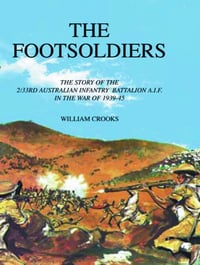The Footsoldiers | Author: William Crooks
THE FOOTSOLDIERS
Few A.I.F. battalions in the history of World War II suffered a worse disaster, in a matter of minutes, than the 2/33rd waiting at Port Moresby on September 7, 1943, to be airlifted for the campaign to re-capture Lae from the Japanese.
The battle-ready troops were in a convoy of 18 trucks at the end of the Jackson's airfield runway when a US Army Air Force B-24 Liberator bomber, taking off on a mission at 4.25am, hit a tree and crashed into five of the trucks.
Horrendous scenes followed as two of the Liberator's 500 lb bombs and more than 3,000 gallons of aviation fuel exploded on impact in a huge fireball.
Seventy-three died as a result of the crash - 60 battalion members, two truck drivers and the 11 crew of the aircraft. Ninety other men were injured in what is still the worst air disaster in Australian history, in peace or war.
Memories of what happened that morning, seeing mates on fire and being blown up by their own ammunition, haunted survivors for the rest of their lives. A commemorative plaque with the names of those who died is on permanent display in the Anzac War Memorial, Hyde Park.
Dramatic eyewitness accounts of survivors are in the battalion's official war history,
The Footsoldiers, which has been republished in a long-awaited second edition.
Written by battalion veteran William Crooks The Footsoldiers is widely acclaimed as one of the five most important unit histories of World War II.
The second edition of has been published to mark the 50th Anniversary of the publication of the first edition in 1971 and to honour and pay tribute to the battalion and the 3,065 men who served in it during World War II, from 1939 to 1945.
Few AIF battalions in World War II achieved a prouder record than the 2/33rd; hard-earned in gallant battles against the Vichy French in Syria and in helping defeat the Japanese in the disease-ridden jungles of Papua, New Guinea and Borneo. The 2/33rd played an important part in helping forge the epic legend of Kokoda, a campaign in which they started with 630 men but after three months of bitter fighting ended with fewer than 130 still able the fight
The rest had been killed, wounded or taken out of action by jungle diseases.
The book is an important addition to the national war records. Crooks’ meticulous and detailed accounts of the battalion’s campaigns took him five years to research and write.
Military historians regard it so highly because it contains graphic details of every action involving the battalion.
The history is based on official war diaries as well as the personal diaries and recollections of hundreds of the men who fought in the various battles, but whose stories had never been told before.
Unlike many war histories written after the event by authors who had never been in the Military, William Crooks, the author of The Footsoldiers , served for five years in the trenches, mountains and jungles alongside men who fought and died in four victorious campaigns.
That service and sacrifice is now proudly enshrined in our nation’s war archives and in the pages of The Footsoldiers, written by one of their own.
It is a fitting epitaph for a gallant battalion that played an important part in helping defeat the enemies of world peace.
The 2/33rd Australian Infantry Battalion Association decided to publish the 50th anniversary second edition to bring the 2/33rd Battalion’s remarkable story to a new generation of readers, as well as being a treasured record for the relatives of the men who served but have been unable to obtain a copy of the long out-of-print first edition.

